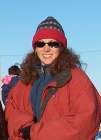 |
|
|
| Author |
Message |
Misty_Nikula-Ohlsen

Joined: 23 Mar 2004
Posts: 74
Location: Barrow, AK

|
 Posted:
Mon Jul 26, 2004 8:10 am Posted:
Mon Jul 26, 2004 8:10 am |
  |
It is HOT in the Arctic! We have all been taking it easy for the past two days, partly because we have a good routine of getting the work done and partly because it has been too NICE to work! Since Friday, it has been warm and sunny. Just enough of a breeze to keep the mosquitoes at bay, too. But as soon as you start hiking through the tundra, you realize that it is really humid and warm! In fact, it has been into the upper 60s and nearly 70 every day. And there is no relief in sight. The forecast is for 65-80 F tomorrow and they are PREDICTING isolated thunderstorms, which are quite a rarity here.
Yesterday, Jenny was still in Atqasuk with Kim and wasn’t planning to come back until the late afternoon flight, so I attended the Saturday Science Presentation. This week, Marcus Sadak, from Michigan State University (and Jenny’s boyfriend), gave a presentation on the uses of Remote Sensing in the Arctic.
Marcus discussed the various types of satellites that are available to image the Arctic (and other areas), how they work and what they measure, and some of the ways that scientists use them for making models and predictions. Then Marcus described his Master’s project that he has been working on for the past year. He wanted to create a model that can be used to monitor and predict carbon flux in the Arctic using remote sensing data. Since the BEO is an area that has a lot of information about the types of plants that cover it and the amounts of carbon that is used and released there, he picked that area as a place to create and test his model. The first thing that he discovered was that he needed an accurate land cover map of the BEO. There was an existing map in which the pixels of the satellite image had been classified as different kinds of ground cover, such as Arctophila, Carex, water, etc. However, when Marcus began to do some ground-truthing of the existing map (a process of checking the classification of the satellite image pixels against the actual places on the ground to see if they are correct), the map was only about 13 % accurate. Not very good! So Marcus’ first step for his project was to improve the accuracy of the map with better methods of classifying the pixels. Currently, he has a map of ground cover that has about 5 ground cover classes and about 79% accuracy, which is much better.

Marcus giving his presentation
When I return back to “civilization” and have a faster Internet connection I will attach an excerpt of Marcus’ presentation which you will be able to download. It will be a zipped PowerPoint presentation.
After Marcus’ presentation, we all went down and sat on the beach for about an hour. Just enjoying the sun and pleasant weather.
I picked up Kim at the airport around 5 pm, we had dinner and tried some fishing at a lake off of Gas Well Road (south of town). We got many bites, but didn’t catch any fish.

Torsten and Heather fishing
Later, we went down to the gravel pit and looked for whale spouts for awhile. We saw only two whales out near the ice pack. The grey whales have been up and down the coast for the past few weeks and we have seen some spouting in the distance nearly every time that we go out to look. But they are always too far to take any pictures.
Today, Kim, Dora and I headed out to BEO first thing. It was beautiful! A bit of a breeze to keep the mosquitoes away for most of the time. Kim downloaded the data and I took pictures of the area around each marker along the three transects for an activity that I am going to have my students do when we return to school. I plan to have them use the pictures to make a hypothesis of which markers will have greater thaw depths and justify their hypothesis. Then they will compare their predictions to the thaw depths that we have measured to see if the data supports their hypothesis.
This afternoon, we are all just taking it easy. I did the preliminary processing of the BEO data and now am just hanging around waiting until it is time to pick up Kirstin from the airport. She returns from St. Louis on the evening flight. Just the lazy days of summer right now, here in Barrow. Whenever you drive through town you see lots of people on the beach having picnics and campfires, children swimming and wading in the water, the trailers of the 30 or so boats that are out with seal and walrus hunters and families taking walks or children riding bikes down the road in shorts and short sleeves. I didn’t think anyone up here would have had reason to OWN shorts!  |
|
|
     |
 |
|
|
|
View next topic
View previous topic
You cannot post new topics in this forum
You cannot reply to topics in this forum
You cannot edit your posts in this forum
You cannot delete your posts in this forum
You cannot vote in polls in this forum
You cannot attach files in this forum
You can download files in this forum
|
Powered by phpBB 2.0.11
© 2001, 2002 phpBB Group :: FI Theme ::
All times are GMT
| |
